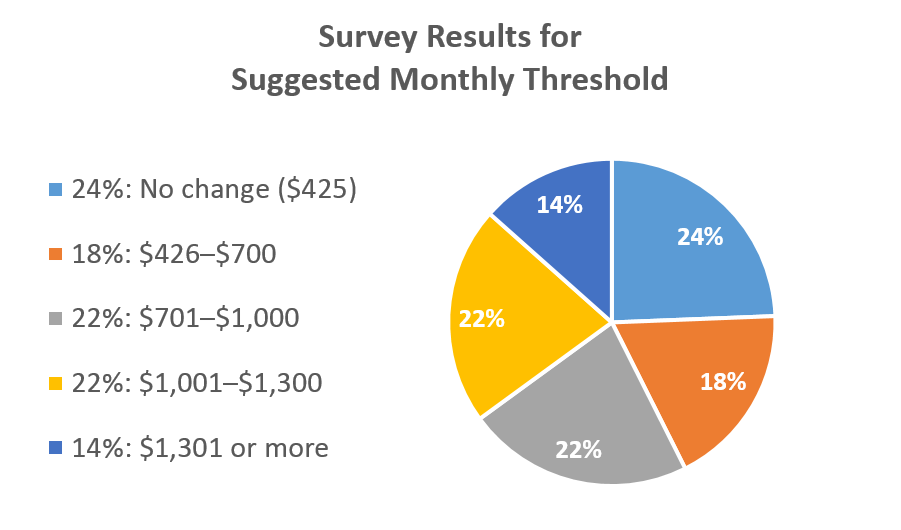|
PERA NEWS: EMPLOYER EDITION
|
|
Winter Newsletter | March 2024
Articles in this newsletter:
- Survey Results: $425 Membership Salary Threshold
- Election Workers: Excluded from PERA Membership
- 2024 IRS Compensation and Contribution Limits
- PERA Reporting and Decimal Points
- Certifying Public Service Prior to July 1, 1989
- Ask PERA: Minnesota Earned Sick and Safe Time Law
- PERA Education: Next Employer Webinar April 25
|
|
Survey Results: $425 Membership Salary Threshold
Thank you to all who participated in PERA’s recent employer survey regarding the $425 monthly threshold.
As you know, effective July 1, 2023, the earnings threshold for PERA’s Coordinated, Correctional, and Police & Fire plans is $425 paid in a single month. This replaced the annualized threshold of $5,100 for local government and $3,800 for school-year employees that was in effect from January 1, 2015, to June 30, 2023.
As detailed in our Fall 2022 newsletter, PERA sought this change as a first step to correct administration issues created by the annual threshold. Our next step is to gather and analyze information from varied sources. The monthly threshold last increased to $425 in 1988, and we wish to allow sufficient time to discuss and evaluate this important membership entrance point before proposing a new threshold amount.
Over 750 survey responses were received with representation across all employer types. We found that one in four felt that the threshold should not be changed, while the remaining 75% supported some degree of increase. The calculation method favored by 60% was an inflation adjustment to convert $425 in 1988 to a present-day value.
During 2024, PERA will continue to engage with employer groups and other stakeholders to develop a proposal for a new threshold amount ahead of the 2025 legislative session.
Again, we wish to thank all who took the time to take our survey. Your feedback is greatly valued as we consider future initiatives for this important eligibility measure.
 Survey Results for Suggested Monthly Threshold

Minnesota has a statewide Section 218 Agreement with the Social Security Administration for election workers, and the same rules apply for each governmental unit in Minnesota.
Who is an election worker? Election workers are individuals hired by government entities to perform services at polling places in connection with national, state, and local elections. Alternate position titles include poll worker, ballot clerk, or voting official. Election workers are often paid a set fee per day or a stipend for the election period, which includes attendance at training or meetings both before and after the election.
PERA Participation. PERA statutes exclude election workers from PERA membership, regardless of the amount of pay they receive.
Social Security and Medicare. In Minnesota, election workers whose pay in a calendar year is less than $2,000 are not subject to Social Security and Medicare (FICA) coverage. However, if an election worker is paid more than $2,000, FICA taxes apply from the first dollar paid.
|

Restrictions affect small percentage of employees.
The Internal Revenue Service (IRS) limits compensation applied to Defined Benefit (DB) Plans and contributions made to PERA’s Defined Contribution Plans (DCP). These limits are defined in Section 415 of the Internal Revenue Code (IRC) and adjusted annually.
For calendar year 2024, IRC Section 401(a)(17) limits compensation subject to retirement contributions to $345,000 for members of PERA’s DB Plans (Coordinated, Correctional and Police & Fire) who initially became plan members on or after July 1, 1995. The limit for employees who were initially enrolled in a DB Plan before July 1, 1995, is $505,000.
IRC Section 415(c)(1)(A) limits the annual contributions a person may make to a DCP. For 2024, that limit is $69,000. The retirement contribution limit represents the annual maximum amount of combined DCP employee and employer contributions that may be credited to a member.
Salary and Contribution Monitoring. The federal limits affect only a small percent of covered employees; however, employers and PERA have a responsibility to monitor each member’s salary and retirement contributions against these limits.
PERA’s prior practice was to evaluate these employees on a yearly basis. However, a review conducted by PERA auditors and its legal advisors has produced a different way to evaluate salary regarding PERA compliance with IRS regulations.
To ensure continued IRS compliance, PERA began evaluating payments through each pay period starting with the calendar year 2022. Therefore, payrolls are now evaluated on a pay period basis.
The following is the limit for an employee based on common pay periods:
-
Annually: $345,000.00
- Monthly: $28,750.00
- Semi-Monthly: $14,375.00
- Bi-Weekly: $13,269.23
Please monitor employee earnings and implement the contribution limits for each pay period. If PERA finds that an employer has reported compensation or contributions in excess of these limits, we will contact you to coordinate an adjustment or refund.
|

Did you know PERA’s two employer reporting sites, ERIS and EFT, are programmed differently when it comes to implied decimal point and values?
ERIS. For employers who utilize ERIS to manually enter SDR data, the decimal point is pre-programmed to remain standing in the data fields.
By simply clicking in the data field, the cursor will start typing to the left of the decimal point, implying .00 as the final numerical value.
To enter decimal values other than .00, you must highlight the data field box and either type over the displayed 0.00 or select Delete to begin typing. You must make sure to enter the decimal point and values afterwards, otherwise the system will program .00 to the end of the value entered.
EFT. Decimal points within the EFT portal are programmed differently depending on which section you are in.
Under Payment Information, the decimal point is implied when entering Payment Amount. Employers must ensure that .XX is entered for the cents portion of the total. If the decimal point and two values are not entered, the system is programmed to enter .00 at the end.
-
Example: your payment is 1000.00 so you enter 100000 and continue entering the other required information. Since no decimal point was entered, the system puts .00 at the end of 100000, so instead of paying 1000.00, the system will indicate 100,000.000 to be withdrawn.
Under Payment Details, the decimal point is not to be entered. This section is reserved for entering two required fields: PERA Employer ID Number and Payroll Paid Date. There are also four supplemental lines to indicate whether an invoice or credit memo are included in the payment amount.
The data field boxes to enter an invoice or credit memo amount are programmed to be numerical values only. No decimal point allowed. Entering a decimal point results in the error message “Must be all numeric” to be displayed. Once the payment is received, PERA’s system automatically populates the decimal point before the last two digits.
-
Example: your payment includes 10.00 extra to pay a delinquency invoice. After adding 10.00 to the payment total, you indicate under Payment Details the invoice number being paid and the invoice amount. You must enter 1000 as the system is programmed to display 10.00 on PERA’s end. If you enter 10, the system will display .10 as the invoice amount to be applied.
It is crucial to confirm the manual SDR entries and payment totals before submitting.
|

State Statute provides for a alternative benefit calculation for members who started public service prior to July 1, 1989. This calculation can be beneficial to members, so you may be asked to verify that they worked for your agency prior to this date.
Pre-1989 employment does not need to have been PERA-eligible employment. However, you must be able to establish that there was a formal employer/employee relationship. PERA provides a form specific to each member that an employer can complete. This form has all the requirements PERA needs to make a determination.
You must be able to certify that the person listed on the form was an employee (not a paid volunteer or paid intern) of your governmental unit prior to July 1, 1989, and that they were compensated for work performed prior to that date. This form must be accompanied by supporting documents proving employment or a signed letter written on your business letterhead certifying that employment. If you cannot verify and prove employment, you should check “No” on the form, sign, and return the form to PERA.
|
|
|

How will the new Minnesota Earned Sick and Safe Time law affect PERA contributions?
Effective Jan. 1, 2024, Minnesota’s earned sick and safe time law requires employers to provide paid leave to employees who work in the state. Sick and safe time is paid leave employers must provide to employees in Minnesota that can be used for certain reasons, including when an employee is sick, to care for a sick family member or to seek assistance if an employee or their family member has experienced domestic abuse, sexual assault or stalking. Visit the MN Department of Labor and Industry website for more information about the law.
For PERA contributions, Sick and Safe leave hours are equivalent to other paid leave types offered by the employer, such as sick time, vacation leave, or paid time off (PTO). Follow PERA’s existing guidelines in Chapter 5 of the Employer Manual to determine what pay is eligible for pension deductions.
|
|
|
Next Live Webinar April 25: Understanding ERIS
This new training program will cover everything you need to know in order to access and utilize ERIS.
When: April 25, 11:00 a.m.
Recommended for: Payroll, HR, and business managers that are new to PERA
Length: 45 minutes
|
|
 |
 |
|
Eligibility Q&A Handout Now Available
On our Employer Programs page, you can access the on-demand version of the eligibility webinar to watch anytime. The Eligibility Overview was updated based on feedback received during the January webinar. We also created the Q&A Handout based on questions received during the last webinar.
|
Upcoming Member Education Programs
PERA offers several ways for members to learn more about their PERA retirement benefit. Check out our current offerings:
Webinar. Registration is now open for webinars in March, April, May, and June. Check out the program calendar for dates and times. We are offering two different virtual programs:
-
Ready to Retire: for members who plan to retire within one year. The content focuses on the application process.
-
From Hire to Retire: for all members to learn about PERA benefits.
In-Person. PERA will be traveling around the state again this summer. From April to September, we will be hosting member education programs in various cities throughout Minnesota. We will be presenting the From Hire to Retire program. The content will be for all members to learn about PERA benefits, brand new employees to those who are near retirement.
Locations and Dates:
- Brainerd – April 3
- Ortonville – May 1
- Willmar – May 3
- Thief River Falls – May 9
- Bemidji – May 10
- St Cloud – May 16 and July 18
- Rochester – June 6
- Austin – June 20
- Fergus Falls – July 10
- Moorhead – July 11
- Mankato – August 8
- Faribault – August 15
- Red Wing – September 12
- Cloquet – September 18
- Hibbing – September 19
PERA will also be hosting the Ready to Retire program in St. Paul on March 15 and April 19.
How to register. Members can register via their myPERA account or by calling our Member Service Center at 651.296.7460 or 1.800.652.9026.
|
|
|
|
|